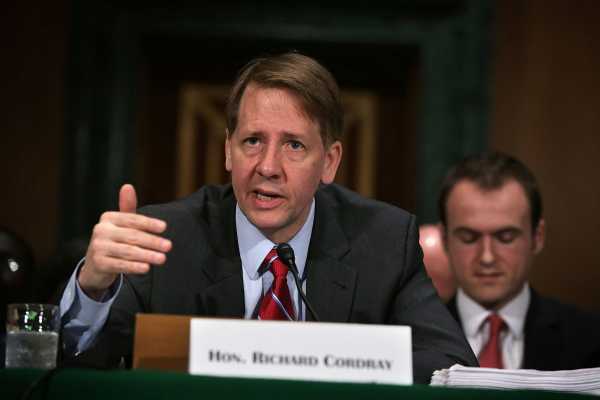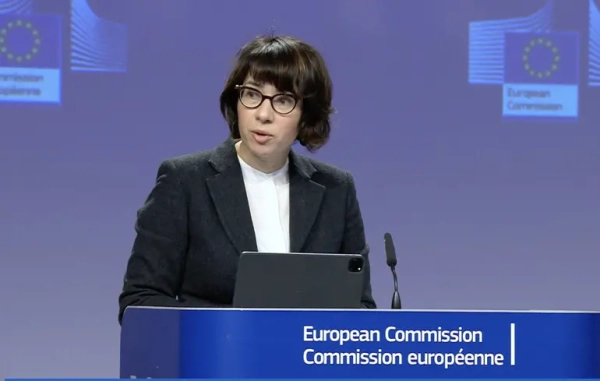
Richard Cordray, the former director of the government’s top consumer watchdog, will be the Democratic nominee for Ohio’s governor after beating Dennis Kucinich in a tense primary contest.
Cordray, 59, served as the first director of the Consumer Financial Protection Bureau from 2012 to 2017. Created under the Dodd-Frank financial reform bill in the wake of the financial crisis, the bureau sought to enhance and enforce consumer rights and protections in the financial arena and areas such as mortgages, lending, and banking. Prior to that, Cordray served as Ohio’s attorney general and state treasurer. He has deep roots in Ohio and was born in Grove City, southwest of Columbus.
In November, he will face off against Ohio’s attorney general, Mike DeWine, the Republican nominee for governor. They’re competing to succeed current Gov. John Kasich.
President Donald Trump on Wednesday morning after the Ohio primary took a swipe at Cordray — without naming him directly. He said Cordray is a “socialist” (he isn’t) and that he was a “big failure in his last job!”
At the CFPB, his last job, Cordray led the way in bringing about $12 billion in relief for harmed consumers and took major enforcement actions against by firms such as Bank of America, Wells Fargo, and Citibank for their wrongdoings.
“By any reasonable standard, his record of protecting consumers was a spectacular success,” Dennis Kelleher, president and CEO of Better Markets, a watchdog group that advocates for stricter financial regulations, told me.
Richard Cordray did a lot as the head of the CFPB
The Consumer Financial Protection Bureau was conceived of by then-Harvard law professor Elizabeth Warren in 2010 and was officially created in July 2010 with Dodd-Frank’s passage. The bureau was met with near-immediate scrutiny from Republicans, who complained it was a severe example of government overreach and that its setup would put too much power in the hands of its single, independent director.
That translated into a contentious battle over President Barack Obama’s decision to tap Cordray to head the CFPB, which he announced in July 2011. Sen. Richard Shelby (R-AL) in a 2011 Wall Street Journal op-ed warned of the “danger of an unaccountable ‘consumer-protection’ czar” and declared Cordray’s nomination “dead on arrival” unless changes to the CFPB’s setup were made.
Obama appointed Cordray anyway during a congressional recess in January 2012, and after a drawn-out fight, the Senate finally confirmed him as CFPB director in July 2013.
And in his more than five years office, Cordray accomplished quite a bit. By the CFPB’s tally, the bureau handled more than 1.2 million consumer complaints and brought about nearly $12 billion in relief for harmed consumers from its inception through July 2017, four months before Cordray’s exit. It required credit card companies to refund about $3 billion for deceptive marketing and enforced millions of dollars in mortgage refunds.
Under Cordray, the CFPB hit Bank of America, JPMorgan Chase, Citibank, and Wells Fargo with multimillion-dollar fines, created new mortgage industry rules meant to avoid another financial crisis, and launched a “Know Before You Owe” initiative to inform consumers before they take out loans. It opened up a public complaints portal for consumers to tell the agency about alleged wrongs by financial companies and laid out for Americans in clear, concise terms information on various financial products, services, and laws.
“There is a long list of very substantial recoveries that the CFPB got for America’s financial consumers from financial companies who were ripping them off,” Kelleher said.
After Cordray left the CFPB, President Trump tapped Office of Management and Budget Director Mick Mulvaney as the bureau’s interim head. (Cordray attempted to make sure Leandra English, the CFPB’s deputy director, was put in as his temporary successor, but a court said Trump had the right to insert Mulvaney. A court battle over the matter remains ongoing, but Mulvaney is still in charge at the moment.)
Mulvaney, who once described the CFPB as a “sick, sad” joke, has worked to weaken the agency and unravel parts of Cordray’s legacy. He’s loosened restrictions and dropped sanctions on predatory payday lenders, weakened the bureau’s anti-discrimination efforts, and even sought to change the agency’s acronym. He’s taken just one enforcement action since taking over, joining another bank regulator to slap Wells Fargo with a $1 billion fine.
“In a very few number of days, the acting director has done a great deal of damage,” Aaron Klein, a fellow in economic studies at the Brookings Institution and former Treasury Department aide, recently told me. “What seems to be happening at the CFPB is kind of a reflexive, anti-whatever the last guy did approach.”
Cordray has Obama Democrats and Elizabeth Warren behind him
Warren endorsed Cordray’s gubernatorial candidacy nearly as soon as it was announced and touted his work at the CFPB. “Wall Street had gambled with our economy, and Ohio families paid the price with their jobs, their homes, and their life savings. So Rich Cordray fought back: He took on AIG. And Merrill Lynch/Bank of America. And Fannie Mae and Freddie Mac. His office forced Wall Street to return nearly $2 billion to the workers, retirees, and investors of Ohio,” she said in a statement at the time. She told voters to “stand with Rich and be one of the first supporters of his campaign to take back Ohio for working families.”
Valerie Jarett, a former senior adviser to President Obama, tweeted out her support for Cordray as well.
Cordray’s campaign announcement video features Obama speaking about him in July 2013. “Americans are better off because of what Rich has done as our consumer watchdog,” the president says.
Warren has campaigned for Cordray in Ohio. She appeared at an opioids event with him in Cincinnati, held a fundraiser for him in Columbus, and took part in a rally for him at Ohio State University. She’s sent multiple campaign emails for him and wrote about him in her 2014 book, A Fighting Chance, in which she described Obama’s decision to overlook her for the CFPB post and give the spot to Cordray instead. “The White House plan was based on the premise that I was radioactive, but someone else could get through the Senate,” she wrote. “If that was correct, then I felt like I knew an inside joke: Any tough director would cause the bad guys a mess of trouble — and Rich is as tough as they come.”
To be sure, the entire Democratic Party isn’t on the same page about Cordray. Our Revolution, the Sanders-aligned progressive group, backed Kucinich in Ohio’s Democratic gubernatorial primary. Sanders himself is staying out of it.
Cordray, like every candidate, has some baggage
Cordray is running alongside Betty Sutton, who is seeking to become Ohio’s next lieutenant governor. The pair’s website outlines a number of issues they say they’ll address or support if elected, including a number of par-for-the-course Democratic items — universal pre-K, free community college, and clean energy. They also emphasize the importance of addressing Ohio’s opioid crisis, estimating it costs the state between $6.6 billion and $8.8 billion every year.
Like most politicians — and, frankly, most people — Cordray brings some baggage with him. The Columbus Dispatch points out that as state treasurer in 2008, Cordray hired Amer Ahmad, who in 2013 pleaded guilty to fraud and other crimes while working for Cordray’s successor, Kevin Boyce. Cordray told the publication there were “no problems” with Ahmad when he was hired and that later “it turned out that he went down the wrong path and became a criminal.”
Cordray also does not have the most progressive record on guns. He supports universal background checks, a ban on high-capacity magazines and bump stocks, and setting the minimum purchase age at 21. He didn’t line up with Kucinich on his call for an assault weapons ban, and his Democratic opponent’s campaign circulated a video of him speaking at a Second Amendment rally while he was attorney general in 2010. Cordray told the Dispatch he was only doing his job at the time.
Per the Dispatch:
In the post-Parkland era when there’s a strong desire for gun control among many Americans, Cordray’s gun record could be somewhat problematic for him with progressives. It could, however, help him win over moderates in the general election.
“There’s no way you can paint Rich Cordray as not being progressive,” the Ohio Democrat recently told Vox’s Dylan Scott. “He’s taken $12 billion away from Wall Street.”
Cordray is kind of a weird tweeter
In January, Cordray took Twitter users by surprise with a whimsical tweet about his home state’s form. “Ohio has a unique and pleasing shape, I have always thought,” he wrote. “Kind of a pentagon or a home plate, with straight sides, a meandering river boundary below, and a partly straight top with a friendly bite mark out of it on the northeast side from Lake Erie.”
A couple of days later, he tweeted out some John Mellencamp lyrics.
Of the tweets, campaign spokesperson Luke Blocher said in a statement that Cordray writes his own tweets and that they “serve as an accurate reflection of who he is: thoughtful, funny, and yes, sometimes a little nerdy.” He said Cordray knows not everyone appreciates his “dad jokes,” but they’re what he wants to do.
And the tweets keep coming. On Tuesday, the day of Cordray’s primary race in Ohio, he tweeted in celebration of the Cleveland Cavaliers’ four-game sweep in its victory over the Toronto Raptors in the NBA playoffs. The image: a broom.
Sourse: vox.com






